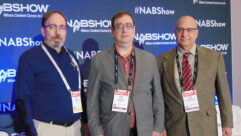The talk in engineering circles has been all about a possible increase in FM digital radio power, allowing HD Radio stations to increase it to as high as 10 percent of analog from the current 1 percent level.
At the NAB Show this was the hot topic for anyone involved in transmission, and a group of leading broadcast organizations now has formally requested such an increase. A rush of new ideas is being discussed on exactly how to manage such a high-power digital operation.
The reason for the buzz is that an increase in FM digital power is a good idea.
We support the concept of more digital power now, not at some point in the future. Radio must make the transition to a digital service, and at current power levels consumer acceptance may be too slow to retain the majority of our current audience in the face of competition. Increased digital power removes one of the most significant barriers to consumer acceptance: limited coverage area.
There are concerns to be addressed. Notably, the impact of increased digital carriers on first-adjacent stations needs to be studied to make sure that the risks to existing analog services are understood fully.
Analog radio still pays all the bills. Nothing will push audiences away faster than ignoring the fact that analog radios are everywhere; digital radios in consumer households still number just a few.
However, with years of digital radio and thousands of station conversions under our belts, we have the knowledge to plan the next step. Field research on receiver performance exists that can be used to generate scientifically valid protection ratios for the increased digital power. This research should lead to an agreed-upon interference standard based on mathematical predictions.
It should be possible to know with good precision where 10 percent digital injection would be harmful and where it would not cause problems.
If necessary, this standard could be used to evaluate proposals for digital power increases to an appropriate level on a case-by-case basis, monitored by the FCC, so that upgrades would be known safe before proceeding.
There is also a concern for the expense. The first phase of digital radio deployment saw many transmitter facilities with 15-year-old equipment receiving major upgrades as a part of their conversion. This investment in FM radio mostly was just good sense, and the extra spent purely on digital generation an exciting part of keeping a station state-of-the-art.
But the large increase for digital injection that is proposed means that in many cases, relatively new equipment will have to be replaced after only a few years of operation if a station wants to upgrade FM digital power. Increasing from 1 percent digital to 10 percent will be a much harder decision than replacing an aging transmitter plant. And for those who have not yet dipped a toe into digital operation, the cost of building a 10 percent digital station will come with significant sticker shock.
If this idea is approved, many stations may not be able to take full advantage due to lack of headroom in the transmitter, increased power bills or interference to radio neighbors. At first, many stations might be limited to a smaller increase, perhaps to 2 or 3 percent of analog.
In spite of these concerns it is worth proceeding with a voluntary increase in digital power to assist the voluntary conversion from analog.
By providing an approximate match to FM analog coverage area, 10 percent digital would allow listeners to take advantage of the superior reception behavior of digital signals, especially on mobile radios. Multicast stations need the additional coverage area because of their lack of an analog fallback. A power boost also would benefit IBOC-FM datacasting, which could pay dividends even if multicast audio doesn’t.
These service extensions deserve to be supported by adequate signal strength. The process of converting to up to 10 percent digital should be done with care and study, but the benefits are worth the pursuit.
— Radio World










